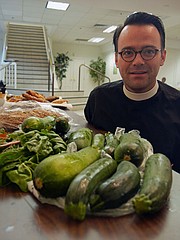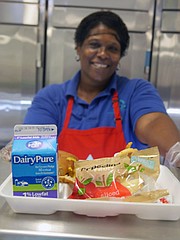Part 1: The Problem
First in a two-part series on childhood hunger in Alexandria.
Childhood hunger in Alexandria is just beyond the doorstep. Some of the underlying causes include lack of knowledge about the existence of the problem or the resources available to alleviate it. There is the high cost of housing and food in the area, the lag behind other local jurisdictions in improved access to food assistance, and inadequate coordination among the many organizations working on the problem.
A report “Toward an End to Hunger in Alexandria,” was released in April 2014, indicating "Alexandria is one of the wealthiest communities in the nation; however, the report estimates that as many as one in five Alexandrians, disproportionately children, are living in households struggling to make ends meet."
The Rev. Ross Kane, coordinator of Outreach Ministries at St Paul's Episcopal Church on S. Pitt Street said, "It (the report) showed us hunger was a bigger problem than I had imagined. This report galvanized a lot of churches and nonprofits to coordinate their concern and to establish Hunger Free Alexandria, a consortium of businesses, faith-based groups and local officials who meet monthly to strategize on how to reduce hunger in Alexandria. You drive through Old Town, and you don't see it … and then you read the statistics on childhood hunger."
Kane said, after the 2014 report was issued, a team of people including a representative from the city as well as St. Paul's Episcopal Church and Christ Church started a food rescue program at the Alexandria Farmer's Market. "Someone is there from one of our churches each week to glean leftover food from farmers, bag it and distribute it at St. Paul's on Tuesday and Christ Church on Thursday."
Kane said that generally 70 percent of the people who come to the churches for food are single mothers. "They spend 60-80 percent of their income on rent so if they can get free food …."
Housing statistics for Alexandria show that housing is often the largest expense faced each month by residents with an average monthly rent of $1,520, higher than the nation as a whole. In addition, about 53.3 percent of renters pay less than 30 percent of their income on rent which it calls, "a measure of affordability."
Kane said, "I'm talking about the other 50 percent. That number is pretty high."
A 2015 report by the National Low-Income Housing Coalition indicated the hourly wages necessary to rent a two-bedroom home in Alexandria are $28.04 per hour while the minimum wage is $7.25 and the average renter wage $16.55 an hour. This same report shows that the City of Alexandria is the most expensive jurisdiction in Virginia.
Programs exist to address the problem of childhood hunger but each faces its own challenges. Lack of transportation is an underlying theme whether it is to the Summer Feeding Program or to a Last Saturday food site. Sometimes it's lack of resources or volunteers. Sometimes it's lack of information for eligible recipients about the programs available to meet their needs. Or it may be refusal to eat the free meals based on the stigma attached to the childhood fear of being labeled poor. Often it’s the practical issue of insufficient food storage or refrigeration.
Food assistance for children comes in many shapes — from programs provided in the schools directly to children such as the Free and Reduced Price School Lunch Program, universal breakfast program, Blessings in a Backpack (BIB) weekend supplementary food for the neediest and the Summer Feeding Program. However, only four schools out of 16 currently offer the universal breakfast program, three schools offer BIB and according to Greg Tardieu, Alexandria grants manager, “We are feeding 200 in the Summer Feeding Program and we should be feeding 2,000.”
In addition to the school-based programs, Alexandria has an Emergency Food System comprised of soup kitchens, food banks and pantries, meals served outside to the homeless or at shelters. These programs are intended to fill the gaps for people who have fallen through the cracks of government assistance.
But a survey of Emergency Food Programs (EFP) released in the 2014 report detailed a number of logistical issues. Only half of the EFPs have sufficient storage space. Other problems were lack of parking, lack of refrigeration, food preparation space, and shelving, and accessibility for clients with disabilities.
Michael Routhouska, principal of William Ramsay Elementary on Sanger Avenue, says his school area has the most affordable housing but the fewest resources. For instance, there is no food bank in the area or storage. They would like to set up a food distribution program at the school but they have to work out a number of logistics such as how to get pallets for food into and out of their parking area.
Melanie Gray, director of Outreach and Mission at Christ Church, says they are working on how to support the West End. She says they can get food but need “people power” to make it work.
ALIVE!, the largest private safety net for the needy in Alexandria, was founded in 1969. Several years ago, in order to address the issues of food storage, Alexandria made available a warehouse space at 801 S. Payne for ALIVE!. After the issuance of the 2014 report on hunger, the city doubled the space with an agreement that organizations would cooperate and work together on their efforts to alleviate hunger.
Diana Charles, executive director of ALIVE!, says the city provides $30,000 a year for operation of ALIVE! programs which include the Last Saturday Program that provides food at three sites once a month for approximately 2,000 individuals, including many children, and the emergency feeding program that delivers food to needy low-income elderly.
Charlotte Martinsson, chair of the ALIVE Food Program, says this operation takes more volunteers than one could imagine. For instance, it takes 50-60 volunteers at each Last Saturday food distribution site. "We could solve world hunger if more people got involved."
In 2016 the percent of enrollment in Alexandria City Public Schools who are eligible for free and reduced price meals averages 59 percent. Cora Kelly Elementary School tops the list with 87 percent eligible, up from 51 percent in 1995 with Ramsay Elementary School not far behind at 85 percent, up from 69 percent in 1995. Patrick Henry Elementary School is third on the list at 78 percent, up from 64 percent in 1995. A school lunch costs $2.65 per student in grades K-5 and $2.85 for grades 6-12. The guidelines for eligibility reflect a scale of income levels depending on size of family and timing of pay periods. For instance, a family of four is eligible if their income is $3,739 a month or lower.
What lies beyond the statistics? Every child has a story. Some educators say hungry children can't concentrate on learning and classroom disruptions are more frequent. Routhouska said, “Food is steel for their minds. We are a focus school and we want to focus on instruction but we want to have food in their bellies. We don't want to have them distracted by hunger." He says before they started the universal breakfast program, "I could tell they were hungry. They might tell me directly."
Keisha Shirley, sixth grade teacher at Francis Hammond Middle School,
said, "A lot of kids were just making it in time to school so I would buy granola bars so they could eat. One day a young student who was always late saw me eating my fruit salad and asked if he could taste it. He ate the whole huge bowl my husband had made me so I knew he was hungry."
Shirley added, "Some of the other kids could often see he was hungry after eating one breakfast bar and showed compassion. They would tell him they had already eaten and he could have their banana bread."
Many agree the biggest problem is lack of knowledge about the existence of the problem in this wealthy area.
Isabel Perez, Community and Schools coordinator at Hammond, said, "People in Alexandria are generous with their resources when they understand the situation. But I feel like I'm living in two worlds. I work in the West End where 75 percent of the students are eligible for reduced or free lunches, and I live in Del Ray where I still have to explain what reduced and free lunches are. "
Next week: “Childhood Hunger in Alexandria — Solutions.”
Donate Food
ALIVE! Most Wanted Foods in Priority Order
- Canned meat (beef stew, chicken, etc.)
- Canned fish (tuna, salmon)
- Peanut Butter
- Cereal *
- Pasta (spaghetti, macaroni, etc.)
- Rice "Kid-friendly" single-serve entrees (e.g. microwavable macaroni and cheese or soups, tuna salad and crackers)
- Canned fruit *
- Canned vegetables
- Spaghetti sauce/canned tomatoes (sauce, diced, etc,)
- Cooking oil (vegetable, canola, etc)
- Canned soup *
- Canned beans
- Jam/Jelly *
Notes: * Healthy choices, such as low or no-sugar added cereals and fruits, and low-sodium soups and vegetables, preferred
For distribution via the ALIVE! Weekend Care Bag program to children in Alexandria schools
* Avoid glass containers whenever possible



